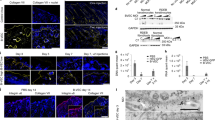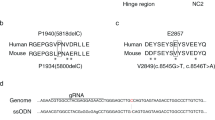Abstract
A major challenge to the concept of gene therapy for dominant disorders is the silencing or repairing of the mutant allele. Supplementation therapy is an alternative approach that aims to bypass the defective gene by inducing the expression of another gene, with similar function but not susceptible to the disrupting effect of the mutant one. Epidermolysis bullosa simplex (EBS) is a genetic skin fragility disorder caused by mutations in the genes for keratins K5 or K14, the intermediate filaments present in the basal cells of the epidermis. Keratin diseases are nearly all dominant in their inheritance. In cultured keratinocytes, mutant keratin renders cells more sensitive to a variety of stress stimuli such as osmotic shock, heat shock or scratch wounding. Using a ‘severe’ disease cell culture model system, we demonstrate reversion towards wild-type responses to stress after transfection with human desmin, an intermediate filament protein normally expressed in muscle cells. Such a supplementation therapy approach could be widely applicable to patients with related individual mutations and would avoid some of the financial obstacles to gene therapy for rare diseases.
This is a preview of subscription content, access via your institution
Access options
Subscribe to this journal
Receive 12 print issues and online access
$259.00 per year
only $21.58 per issue
Buy this article
- Purchase on Springer Link
- Instant access to full article PDF
Prices may be subject to local taxes which are calculated during checkout





Similar content being viewed by others
References
Cao T, Wang XJ, Roop DR . Regulated cutaneous gene delivery: the skin as a bioreactor. Hum Gene Ther 2000; 11: 2297–2300.
Spirito F, Meneguzzi G, Danos O, Mezzina M . Cutaneous gene transfer and therapy: the present and the future. J Gene Med 2001; 3: 21–31.
Cao T et al. The epidermis as a bioreactor: topically regulated cutaneous delivery into the circulation. Hum Gene Ther 2002; 13: 1075–1080.
Coulombe PA et al. Point mutations in human keratin 14 genes of epidermolysis bullosa simplex patients: genetic and functional analyses. Cell 1991; 66: 1301–1311.
Bonifas JM, Rothman AL, Epstein Jr EH . Epidermolysis bullosa simplex: evidence in two families for keratin gene abnormalities. Science 1991; 254: 1202–1205.
Lane EB et al. A mutation in the conserved helix termination peptide of keratin 5 in hereditary skin blistering. Nature 1992; 356: 244–246.
Porter RM, Lane EB . Phenotypes, genotypes and their contribution to understanding keratin function. Trends Genet 2003; 19: 278–285.
Letai A et al. Disease severity correlates with position of keratin point mutations in patients with epidermolysis bullosa simplex. Proc Natl Acad Sci USA 1993; 90: 3197–3201.
Fine JD, McGrath J, Eady RA . Inherited epidermolysis bullosa comes into the new millenium: a revised classification system based on current knowledge of pathogenetic mechanisms and the clinical, laboratory, and epidemiologic findings of large, well-defined patient cohorts. J Am Acad Dermatol 2000; 43: 135–137.
Alexeev V et al. Localized in vivo genotypic and phenotypic correction of the albino mutation in skin by RNA–DNA oligonucleotide. Nat Biotechnol 2000; 18: 43–47.
Gorman L, Glazer PM . Directed gene modification via triple helix formation. Curr Mol Med 2001; 1: 391–399.
Vasquez KM, Glazer PM . Triplex-forming oligonucleotides: principles and applications. Q Rev Biophys 2002; 35: 89–107.
Guntaka RV, Varma BR, Weber KT . Triplex-forming oligonucleotides as modulators of gene expression. Int J Biochem Cell Biol 2003; 35: 22–31.
Richardson PD, Augustin LB, Kren BT, Steer CJ . Gene repair and transposon-mediated gene therapy. Stem Cells 2002; 20: 105–118.
Kurreck J . Antisense technologies. Improvement through novel chemical modifications. Eur J Biochem 2003; 270: 1628–1644.
McManus MT, Sharp PA . Gene silencing in mammals by small interfering RNAs. Nat Rev Genet 2002; 3: 737–747.
Scherr M, Morgan MA, Eder M . Gene silencing mediated by small interfering RNAs in mammalian cells. Curr Med Chem 2003; 10: 245–256.
Samarsky D, Ferbeyre G, Bertrand E . Expressing active ribozymes in cells. Curr Issues Mol Biol 2000; 2: 87–93.
Kashani-Sabet M . Ribozyme therapeutics. J Invest Dermatol Symp Proc 2002; 7: 76–78.
Magin TM et al. Supplementation of a mutant keratin by stable expression of desmin in cultured human EBS keratinocytes. J Cell Sci 2000; 113: 4231–4239.
Johnson RG, Sheridan JD . Junctions between cancer cells in culture: ultrastructure and permeability. Science 1971; 174: 717–719.
Hedberg KK, Chen LB . Absence of intermediate filaments in a human adrenal cortex carcinoma-derived cell line. Exp Cell Res 1986; 163: 509–517.
Kinsella TM, Nolan GP . Episomal vectors rapidly and stably produce high-titer recombinant retrovirus. Hum Gene Ther 1996; 7: 1405–1413.
Pear WS, Nolan GP, Scott ML, Baltimore D . Production of high-titer helper-free retroviruses by transient transfection. Proc Natl Acad Sci USA 1993; 90: 8392–8396.
Morley SM et al. Generation and characterization of epidermolysis bullosa simplex cell lines: scratch assays show faster migration with disruptive keratin mutations. Br J Dermatol 2003; 149: 46–58.
Purkis PE et al. Antibody markers of basal cells in complex epithelia. J Cell Sci 1990; 97: 39–50.
D'Alessandro M et al. Keratin mutations of epidermolysis bullosa simplex alter the kinetics of stress response to osmotic shock. J Cell Sci 2002; 115: 4341–4351.
Morley SM et al. Temperature sensitivity of the keratin cytoskeleton and delayed spreading of keratinocyte lines derived from EBS patients. J Cell Sci 1995; 108 (Part 11): 3463–3471.
Kirfel J et al. Ectopic expression of desmin in the epidermis of transgenic mice permits development of a normal epidermis. Differentiation 2002; 70: 56–68.
Lazarides E, Hubbard BD . Immunological characterization of the subunit of the 100 A filaments from muscle cells. Proc Natl Acad Sci USA 1976; 73: 4344–4348.
Pieper FR et al. Transgenic expression of the muscle-specific intermediate filament protein desmin in nonmuscle cells. J Cell Biol 1989; 108: 1009–1024.
Ngai J, Coleman TR, Lazarides E . Localization of newly synthesized vimentin subunits reveals a novel mechanism of intermediate filament assembly. Cell 1990; 60: 415–427.
Berteretche MV et al. Abnormal incisor-tooth differentiation in transgenic mice expressing the muscle-specific desmin gene. Eur J Cell Biol 1993; 62: 183–193.
Weitzer G et al. Cytoskeletal control of myogenesis: a desmin null mutation blocks the myogenic pathway during embryonic stem cell differentiation. Dev Biol 1995; 172: 422–439.
Watson PA, Hannan R, Carl LL, Giger KE . Desmin gene expression in cardiac myocytes is responsive to contractile activity and stretch. Am J Physiol 1996; 270: C1228–1235.
Brunette DM . Mechanical stretching increases the number of epithelial cells synthesizing DNA in culture. J Cell Sci 1984; 69: 35–45.
Takei T et al. Effect of strain on human keratinocytes in vitro. J Cell Physiol 1997; 173: 64–72.
Kippenberger S et al. Signaling of mechanical stretch in human keratinocytes via MAP kinases. J Invest Dermatol 2000; 114: 408–412.
Li H, Capetanaki Y . Regulation of the mouse desmin gene: transactivated by MyoD, myogenin, MRF4 and Myf5. Nucleic Acids Res 1993; 21: 335–343.
Li H, Capetanaki Y . An E box in the desmin promoter cooperates with the E box and MEF-2 sites of a distal enhancer to direct muscle-specific transcription. EMBO J 1994; 13: 3580–3589.
Gao J, Li Z, Paulin D . A novel site, Mt, in the human desmin enhancer is necessary for maximal expression in skeletal muscle. J Biol Chem 1998; 273: 6402–6409.
Acknowledgements
This work was supported by the Dystrophic Epidermolysis Bullosa Research Association (DEBRA) (LANE3 to EBL, supporting MD), Cancer Research UK (C26/A1461 to EBL, supporting SMM, RMP and PHO) and the Wellcome Trust (055090 to EBL, supporting ML). We are grateful to G Nolan and co-workers, and to P Marinkovich, for introducing us to the retroviral vector and packaging cells and providing us with stocks, and to Dan Gibbs for the initial discussions that led to these experiments.
Author information
Authors and Affiliations
Rights and permissions
About this article
Cite this article
D'Alessandro, M., Morley, S., Ogden, P. et al. Functional improvement of mutant keratin cells on addition of desmin: an alternative approach to gene therapy for dominant diseases. Gene Ther 11, 1290–1295 (2004). https://doi.org/10.1038/sj.gt.3302301
Received:
Accepted:
Published:
Issue Date:
DOI: https://doi.org/10.1038/sj.gt.3302301
Keywords
This article is cited by
-
Keratin 14-Null Cells as a Model to Test the Efficacy of Gene Therapy Approaches in Epithelial Cells
Journal of Investigative Dermatology (2011)
-
The molecular basis of human keratin disorders
Human Genetics (2009)
-
Discrimination of epithelium-like and fibroblast-like phenotypes derived from ethanol-treated immortalised human gingival keratinocytes in epithelial equivalents
Cell and Tissue Research (2008)
-
Gene therapy progress and prospects: the skin – easily accessible, but still far away
Gene Therapy (2006)



